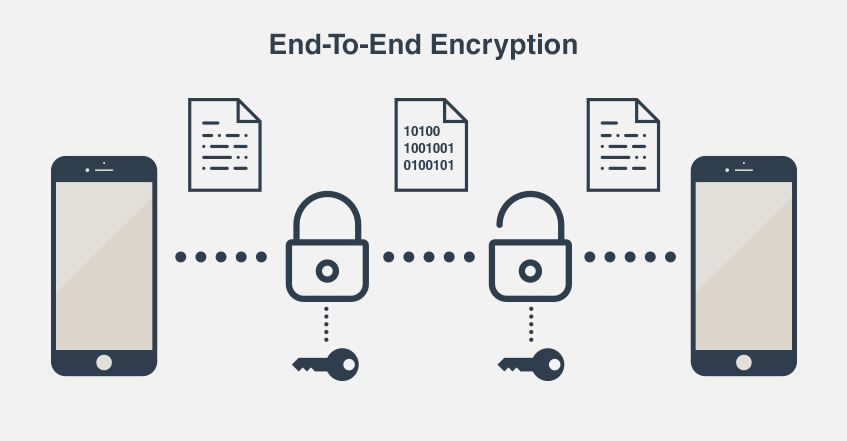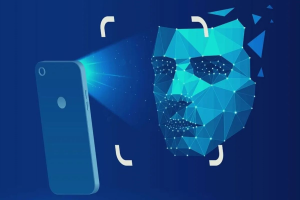Learn how End-to-End Encryption protects mobile app data with secure algorithms, key management, and seamless UX. Discover strategies for performance, compliance, and future-ready security.

Introduction: Why End-to-End Encryption is Critical
End-to-End Encryption ensures that mobile apps protect sensitive user data across identity, finance, healthcare, and enterprise access. Data remains unreadable to anyone outside the communication path, including cloud providers and app vendors.
-
Introduction: Why End-to-End Encryption is Critical
-
Why End-to-End Encryption Matters in Modern Mobile Products
-
Data Breaches Are Inevitable
-
Privacy-First Product Era
-
Trust-Driven Product Growth
-
-
Core Principles of End-to-End Encryption
-
Cryptographic Keys Stay With Users
-
Zero-Knowledge Architecture
-
Secure Key Generation & Storage
-
Forward & Future Secrecy
-
-
Encryption Algorithms for Mobile Security
-
Symmetric Encryption: AES-256, ChaCha20
-
Asymmetric Encryption: RSA, ECC, Curve25519
-
Hashing & Integrity: SHA-256, HMAC
-
Post-Quantum Cryptography
-
-
Building an End-to-End Encryption Architecture
-
On-Device Key Generation
-
Key Storage Strategies
-
Secure Key Exchange Protocols
-
Encrypted Communication Layer
-
Backup & Key Recovery
-
-
Performance & ux Considerations
-
Optimizing Battery & CPU
-
Ensuring Smooth User Experience
-
-
Testing & Validation of E2EE
-
Cryptographic Validation
-
Pen-Testing and Red-Team Simulations
-
Network Tampering and Reverse Engineering
-
-
Business & Engineering Benefits
-
Real-World Use Cases
-
Conclusion: E2EE as a Trust Strategy
-
Executive Summary
In today’s digital infrastructure, mobile apps have evolved into permanent gateways of personal identity, financial activity, healthcare interactions, enterprise access, and private communication. With this evolution, data privacy and confidentiality are no longer optional — they are foundational pillars of product trust and business credibility.
Among all defensive techniques, End-to-End Encryption (E2EE) stands as the most powerful shield. It ensures that data remains encrypted from sender to receiver — unreadable to anyone in between, including cloud platforms, app vendors, network providers, and infrastructure administrators.
Modern users don’t simply use apps — they trust apps with their lives, routines, and decisions. E2EE is the framework that ensures this trust is not misplaced.
This article explores strategic implementation, encryption algorithms, key-handling best practices, UX-performance balance, and architectural considerations for deploying E2EE in mobile ecosystems — especially at scale.
Why End-to-End Encryption Matters in Modern Mobile Products
1. Data Breaches Are Inevitable — E2EE Makes Them Useless
Even the world’s most secure infrastructure faces potential intrusion. What differentiates resilient applications?
Not preventing breaches — but ensuring breached data is unreadable.
With E2EE:
Database exposure ≠ Data theft
Network interception ≠ Communication leakage
Compromised servers ≠ Compromised privacy
2. The Era of Privacy-First Products
Privacy laws and user expectations drive encryption adoption:
- GDPR / CCPA
- Digital Markets Act
- HIPAA & HITRUST
- Open Banking & PSD2
- Apple ATT & Google Privacy Sandbox
Regulators are not asking for encryption; they are mandating provable privacy controls. E2EE isn’t just compliance — it’s a competitive advantage.
3. Trust-Driven Product Growth
Apps that use encryption as a selling point outperform.
Platforms like WhatsApp, Signal, Proton, and Apple Wallet built brand loyalty around data sovereignty. In the next decade, every serious product — from enterprise SaaS to decentralized consumer apps — will follow this path.
Secure apps don’t win users. Trusted apps do. And trust begins with encryption.
Core Principles of End-to-End Encryption
Cryptographic Keys Stay With the Users
Data is encrypted on the sender device
Travels encrypted
Stays encrypted in storage
Decrypted only on receiver device
No middle service can read messages — not even the app owner.
Zero-Knowledge Engineering
Platform operators must be unable to access data.
Users hold cryptographic control “Your key, your data.”
Secure Key Generation & Storage
Keys are generated on-device using secure cryptographic libraries. They never travel over networks or exist in plaintext.
Forward & Future Secrecy
If one encryption key is compromised, previous and future communication remains secure.
Encryption Algorithms for Mobile End-to-End Security

Symmetric Encryption (Fast for Local / Streaming Data)
| Algorithm | Purpose | Strength |
| AES-256-GCM | General encryption | Gold standard, fast & secure |
| ChaCha20-Poly1305 | Mobile optimization | Faster on mobile CPUs, battery-efficient |
AES vs ChaCha20?
- AES faster on hardware-accelerated chips
- ChaCha20 better for low-power devices & mobile CPUs
Asymmetric Encryption (For Key Exchange)
| Algorithm | Use | Notes |
| RSA-2048/4096 | Legacy secure key exchange | Reliable but heavy |
| Elliptic Curve Cryptography (ECC) | Modern secure key exchange | Fast, secure, mobile-friendly |
| Curve25519 / X25519 | State-of-art key agreement | Used by Signal, WhatsApp |
Hashing & Integrity
| Algorithm | Purpose |
| SHA-256 / SHA-3 | Hashing + signatures |
| HMAC | Msg integrity + auth |
Emerging — Post-Quantum Cryptography (PQC)
As quantum computers evolve, encryption needs quantum-resistant algorithms.
Examples:
- Kyber (Key encapsulation)
- Dilithium (Signatures)
Future-proof mobile apps must plan PQC migration now.
Building an End-to-End Encryption Architecture
1. On-Device Key Generation
Use secure cryptographic libraries:
- iOS: CryptoKit + Secure Enclave
- Android: Jetpack Security + TEE / StrongBox
- Cross-Platform: libsodium, OpenSSL, WebCrypto
Keys never leave the device in plaintext.
2. Key Storage Strategy
Use secure OS modules:
| Platform | Storage Mechanism |
| Apple | Secure Enclave + Keychain |
| Android | Hardware-Backed Keystore |
| Cloud | HSMs + KMS + multi-party key split |
Avoid storing keys inside app storage or backend DBs.
3. Secure Key Exchange Protocols
Use protocols proven by global messaging apps:
- Diffie-Hellman Key Exchange (ECDH)
- Signal Double-Ratchet Protocol (Modern gold standard)
4. Encrypted Communication Layer
Encrypt:
Requests & responses
WebSockets
Push notification payloads
Local storage
Cache files
Logs & debugging data (easily overlooked!)
5. Backup & Key Recovery
E2EE fails if users lose keys and can’t recover data.
Secure methods:
- Encrypted key escrow w/ user-generated passphrase
- Multi-factor recovery keys
- Shamir Secret Sharing for enterprise apps
Never store plaintext backups.
Performance & UX Considerations
Optimize for Battery & CPU
Encryption shouldn’t drain the device.
Tips:
- Use ChaCha20 for mobile performance
- Encrypt in streams for large files
- Run crypto tasks in background threads
UX Matters in Security
Users shouldn’t feel encryption.
Good UX patterns:
- Silent background key rotation
- Auto-secure local storage
- Fast biometric unlock
- Offline encryption capability
Secure but Smooth Messaging
Encrypting every message individually ensures:
- Forward secrecy
- Replay protection
- Granular access control
Testing & Validating E2EE

Security Testing Requirements
| Category | Tools |
| Cryptographic validation | OpenSSL, libsodium test suites |
| Pen-testing | OWASP MASVS |
| Memory & key leakage tests | Frida, MobSF |
| Network tampering | Burp Suite, mitmproxy |
| Reverse engineering | Obfuscation, integrity checks |
Red-Team Simulation
Simulate:
- Backend breach
- DNS hijacking
- Compromised device
- Network interception
- Cloud database leakage
If encrypted data remains unreadable → You’re succeeding.
Business & Engineering Benefits
| Benefit | Impact |
| Regulatory compliance | Avoid penalties + audits |
| Brand trust | Higher user adoption |
| Competitive moat | Hard to replicate quickly |
| Future-proof security | Resistant to breaches & quantum era |
| Reduced liability | Encrypted data ≠ exposed breach |
Real-World Use Cases
| Sector | E2EE Value |
| Finance/Banking | Secure transactions & identity |
| Healthcare | Medical privacy & HIPAA compliance |
| Enterprise SaaS | Confidential collaboration |
| Cloud storage | Zero-knowledge syncing |
| Messaging apps | Private communication |
| IoT | Secure device networks |
Conclusion
End-to-End Encryption is not simply a security feature — it is the structural layer of trust in the modern digital ecosystem. As mobile apps become gateways to identity, finance, health, and enterprise access, safeguarding data with E2EE has become a moral, commercial, and engineering responsibility.
Winning digital trust is no longer just about features — it’s about protecting user sovereignty. Companies that adopt strong E2EE frameworks now will lead the next decade of the privacy-driven internet.
If your architecture protects your users’ data even from you, you’re building the future.
Executive Summary
- End-to-End Encryption ensures only users can access shared data
- Combines AES / ChaCha20, ECC, SHA-256, and secure key storage
- Requires on-device key generation, zero-knowledge architecture
- Must consider performance, battery, and UX clarity
- Provides strategic advantage in trust, compliance, and security
- Future-ready systems plan for post-quantum cryptography
- E2EE is not just technical; it’s a competitive trust strategy


